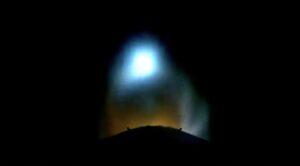Terran Orbital's GEOStare SV2 completes commercial imaging contract for Lockheed Martin
Tuesday, 10 January 2023 05:17 Terran Orbital Corporation (NYSE: LLAP), a global leader in satellite-based solutions primarily serving the aerospace and defense industries, has announced its GEOStare SV2 spacecraft completed a commercial data services imagery contract for Lockheed Martin.
Throughout the duration of the contract, Terran Orbital's operations team successfully demonstrated the ability to rapidly re-task th
Terran Orbital Corporation (NYSE: LLAP), a global leader in satellite-based solutions primarily serving the aerospace and defense industries, has announced its GEOStare SV2 spacecraft completed a commercial data services imagery contract for Lockheed Martin.
Throughout the duration of the contract, Terran Orbital's operations team successfully demonstrated the ability to rapidly re-task th Chinese scientists discover ubiquitous, increasing ferric iron on lunar surface
Tuesday, 10 January 2023 05:17 The Moon has been considered extremely reductive since the Apollo era, as estimated by the low ferric iron content in lunar samples returned in the 1970s. In addition, it has long been a mystery whether a large amount of ferric iron exists on the Moon and how it is formed.
Recently, however, a research team led by Profs. XU Yigang and HE Hongping from the Guangzhou Institute of Geochemistr
The Moon has been considered extremely reductive since the Apollo era, as estimated by the low ferric iron content in lunar samples returned in the 1970s. In addition, it has long been a mystery whether a large amount of ferric iron exists on the Moon and how it is formed.
Recently, however, a research team led by Profs. XU Yigang and HE Hongping from the Guangzhou Institute of Geochemistr Webb reveals wide diversity of galaxies in the early universe
Tuesday, 10 January 2023 05:17 New data from the James Webb Space Telescope (JWST) have revealed that the structures of galaxies in the early universe were much more diverse and mature than previously known. Scientists compared images of hundreds of galaxies taken by JWST for the Cosmic Evolution Early Release Science (CEERS) Survey with corresponding images previously taken by the Hubble Space Telescope and presented the res
New data from the James Webb Space Telescope (JWST) have revealed that the structures of galaxies in the early universe were much more diverse and mature than previously known. Scientists compared images of hundreds of galaxies taken by JWST for the Cosmic Evolution Early Release Science (CEERS) Survey with corresponding images previously taken by the Hubble Space Telescope and presented the res Speedcast wins contract renewal for Asia-Pacific Teleport Services
Tuesday, 10 January 2023 05:17 Speedcast, a leading communications and IT services provider, has been awarded a contract extension by Airbus to provide gateway hosting services offering secure access to its SKYNET military satellite system from the Asia-Pacific region. Airbus is the trusted partner for the UK's secure military satellite communications program.
In 2016, Speedcast built two 11m antenna systems at one of i
Speedcast, a leading communications and IT services provider, has been awarded a contract extension by Airbus to provide gateway hosting services offering secure access to its SKYNET military satellite system from the Asia-Pacific region. Airbus is the trusted partner for the UK's secure military satellite communications program.
In 2016, Speedcast built two 11m antenna systems at one of i Blue Canyon Technologies provides small satellite critical technologies on Transporter-6 Launch
Tuesday, 10 January 2023 05:17 Small satellite manufacturer and mission services provider Blue Canyon Technologies, LLC ("BCT" or "Blue Canyon"), a subsidiary of Raytheon Technologies, has announced its contributions to the first orbital launch of 2023. The Transporter-6 launch pitched 114 small payloads into polar orbit on January 3, with Blue Canyon providing critical hardware components for several of the SmallSat missions
Small satellite manufacturer and mission services provider Blue Canyon Technologies, LLC ("BCT" or "Blue Canyon"), a subsidiary of Raytheon Technologies, has announced its contributions to the first orbital launch of 2023. The Transporter-6 launch pitched 114 small payloads into polar orbit on January 3, with Blue Canyon providing critical hardware components for several of the SmallSat missions First rocket launch of the New Year leaves Wenchang for space
Tuesday, 10 January 2023 05:17 China launched a Long March 7A rocket from the Wenchang Space Launch Center in Hainan province on Monday morning, sending three satellites into space as part of its first space mission of 2023.
The colossal 60.1-meter rocket blasted off at 6:00 am from the coastal launch center, and soon deployed the Shijian 23 and Shiyan 22A and 22B experimental satellites into orbit, according to a news
China launched a Long March 7A rocket from the Wenchang Space Launch Center in Hainan province on Monday morning, sending three satellites into space as part of its first space mission of 2023.
The colossal 60.1-meter rocket blasted off at 6:00 am from the coastal launch center, and soon deployed the Shijian 23 and Shiyan 22A and 22B experimental satellites into orbit, according to a news NASA selects experimental space technology concepts for initial study
Tuesday, 10 January 2023 05:17 Imagine a future in space where pellet-beam propulsion systems speed up travel to other worlds, pipelines on the Moon transport oxygen between settlements, and Martian bricks grow on their own before being assembled into homes. Researchers will delve into these ideas and more using NASA grant funding.
The NASA Innovative Advanced Concepts (NIAC) program fosters innovation by funding early-
Imagine a future in space where pellet-beam propulsion systems speed up travel to other worlds, pipelines on the Moon transport oxygen between settlements, and Martian bricks grow on their own before being assembled into homes. Researchers will delve into these ideas and more using NASA grant funding.
The NASA Innovative Advanced Concepts (NIAC) program fosters innovation by funding early- Webb reveals links between galaxies near and far
Tuesday, 10 January 2023 05:17 A new analysis of distant galaxies imaged by NASA's James Webb Space Telescope shows that they are extremely young and share some remarkable similarities to "green peas," a rare class of small galaxies in our cosmic backyard.
"With detailed chemical fingerprints of these early galaxies, we see that they include what might be the most primitive galaxy identified so far. At the same time, we
A new analysis of distant galaxies imaged by NASA's James Webb Space Telescope shows that they are extremely young and share some remarkable similarities to "green peas," a rare class of small galaxies in our cosmic backyard.
"With detailed chemical fingerprints of these early galaxies, we see that they include what might be the most primitive galaxy identified so far. At the same time, we China's first private sector 2023 rocket launch up, up and away
Tuesday, 10 January 2023 05:17 Galactic Energy, a private aerospace manufacturer in Beijing, launched its fifth Ceres 1 rocket on Monday afternoon, deploying five small satellites into orbit.
The Ceres 1 Y5 rocket blasted off at 1:04 pm from the Jiuquan Satellite Launch Center in the Gobi Desert and placed the satellites into a preset orbit shortly after, the company announced in a news release.
It was China's fir
Galactic Energy, a private aerospace manufacturer in Beijing, launched its fifth Ceres 1 rocket on Monday afternoon, deploying five small satellites into orbit.
The Ceres 1 Y5 rocket blasted off at 1:04 pm from the Jiuquan Satellite Launch Center in the Gobi Desert and placed the satellites into a preset orbit shortly after, the company announced in a news release.
It was China's fir Commercial innovation for NOAA ground enterprise architecture
Tuesday, 10 January 2023 04:24
NOAA would “far exceed the funds available” if the agency carries out plans to expand its constellation through 2042 without changing its ground architecture, said Michael Morgan, Commerce Department assistant secretary for environmental observation and prediction.
The post Commercial innovation for NOAA ground enterprise architecture appeared first on SpaceNews.
Historic UK rocket mission ends in failure
Tuesday, 10 January 2023 01:07 An attempt to launch the first rocket into orbit from UK soil ended in failure on Tuesday, with scientists reporting an "anomaly" as it neared its goal.
A Virgin Orbit Boeing 747 carrying the 70-foot (21-metre) rocket took off from a spaceport in Cornwall, southwest England, at 2202 GMT.
The rocket then detached from the aircraft and ignited as planned at a height of 35,000 feet over the
An attempt to launch the first rocket into orbit from UK soil ended in failure on Tuesday, with scientists reporting an "anomaly" as it neared its goal.
A Virgin Orbit Boeing 747 carrying the 70-foot (21-metre) rocket took off from a spaceport in Cornwall, southwest England, at 2202 GMT.
The rocket then detached from the aircraft and ignited as planned at a height of 35,000 feet over the First Virgin Orbit U.K. launch fails
Tuesday, 10 January 2023 00:39
Virgin Orbit’s first launch from the United Kingdom failed to reach orbit Jan. 9, dealing a high-profile setback to a company that has been struggling financially.
The post First Virgin Orbit U.K.
European firms partner for LEO collision avoidance demo
Monday, 09 January 2023 21:23
Three young European space companies said Jan. 9 they have teamed up to test a collision avoidance system on a small satellite this year in low Earth orbit.
The post European firms partner for LEO collision avoidance demo appeared first on SpaceNews.
Observing lightning with a cubesat constellation
Monday, 09 January 2023 21:17
NASA Marshall Space Flight Center is working with Los Alamos National Laboratories and the University of Alabama, Huntsville, on Cubespark, a proposed constellation of six cubesats to map lightning.
The post Observing lightning with a cubesat constellation appeared first on SpaceNews.
Full moon rising: The first lunar spectacle of 2023 is this weekend's wolf moon
Monday, 09 January 2023 20:50
If you lift your eyes to the sky Friday night, you can catch the first full moon of 2023—the wolf moon.
The full moon can best be seen at 6:08 p.m. EST on Friday and will appear full through Sunday morning, according to NASA.
"Look for the moon to rise from the northeastern horizon around sunset that evening," according to the Old Farmer's Almanac.
This is the first of 13 full moons in 2023, the Old Farmer's Almanac said.
The moon is also known as a micromoon, because the moon, which circles the Earth in an elliptical orbit, is farther from the Earth, said Space.com.
Why is it called the wolf moon?
The first full moon of the year is known as the wolf moon because historically it was believed during the winter wolves howled more at night because they were hungry, the Old Farmer's Almanac said.
The name has stuck even though there are doubts about the accuracy of the wolf moon moniker.
Why is it also called a micromoon?
For this full moon, the moon will be about 250,000 miles from Earth.

